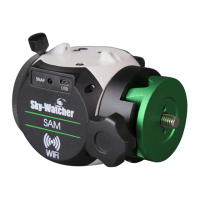Polar Alignment
Polar Alignment refers to the procedure for aligning SAM’s rotaonal axis
with the Earth’s rotaonal axis. If we extend Earth’s rotaonal axis out
into space it intersects an imaginary point called the Celesal Pole. In the
Northern hemisphere we refer to that point as the North Celesal Pole,
or NCP for short. In the Southern hemisphere it is the South Celesal
Pole or SCP.
Because the celesal poles are imaginary points, there is nothing to see
at their locaons. This can make poinng at them a bit of a challenge!
However, there are a couple of celesal land marks nearby the poles that
help us along. In the north it is Polaris, the North Star. In the south it is
the star Sigma Octanis.
Polar Alignment in the Northern Hemisphere
To polar align SAM with the NCP follow this procedure. It is best to do this
at dusk when you can just see Polaris, but before it is completely dark so
that you can more easily see what you are doing. Also, it’s always good
pracce to save the dark for taking your pictures, not for seng up your
equipment. The following steps assume you have a lt/pan head or ball
mount aached to your tripod:
1. Set up your tripod and be sure that it is secure.
2. Aach SAM to the lt/pan or ball head. The Polar View Finder
should be on top and the saddle facing north.
3. Now, angle the lt/head or ball mount up and rotate so that you
can see Polaris in the eld of view of the Polar View Finder. This is
all you will need to do when using short focal length lenses and/or
exposures that are only a few seconds long. If you are using longer
focal length lenses (e.g., greater than 100 mm or so) or exposures
exceeding 30 – 60s then you may get beer results by following the
steps outlined in Appendix I: Advanced Polar Alignment Procedures.
Polaris .
Look through
the Polar View
Finder and align
on Polaris, making
adjustments with
your lt/pan head
or ball mount.
19

